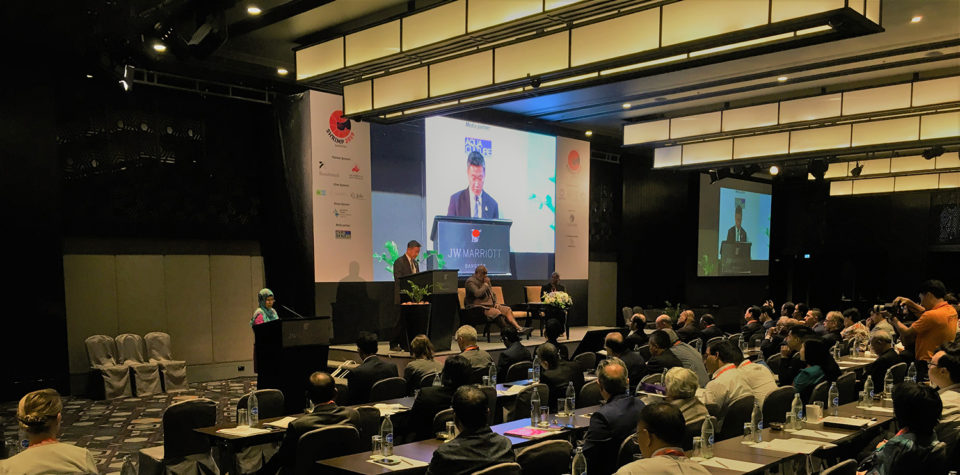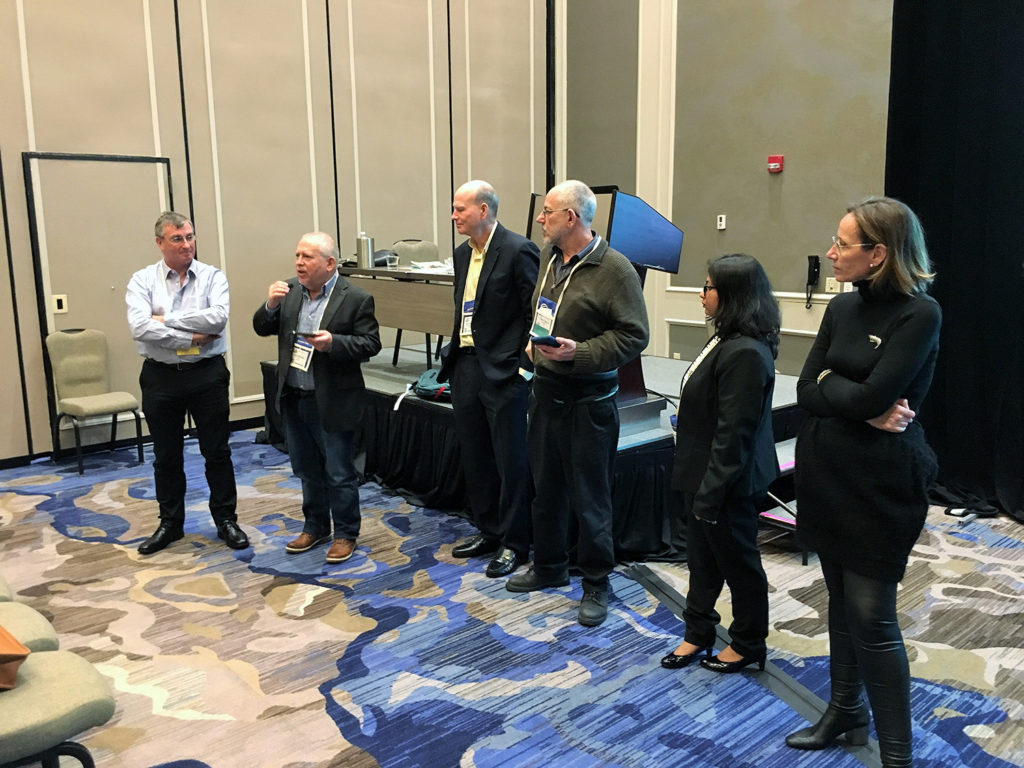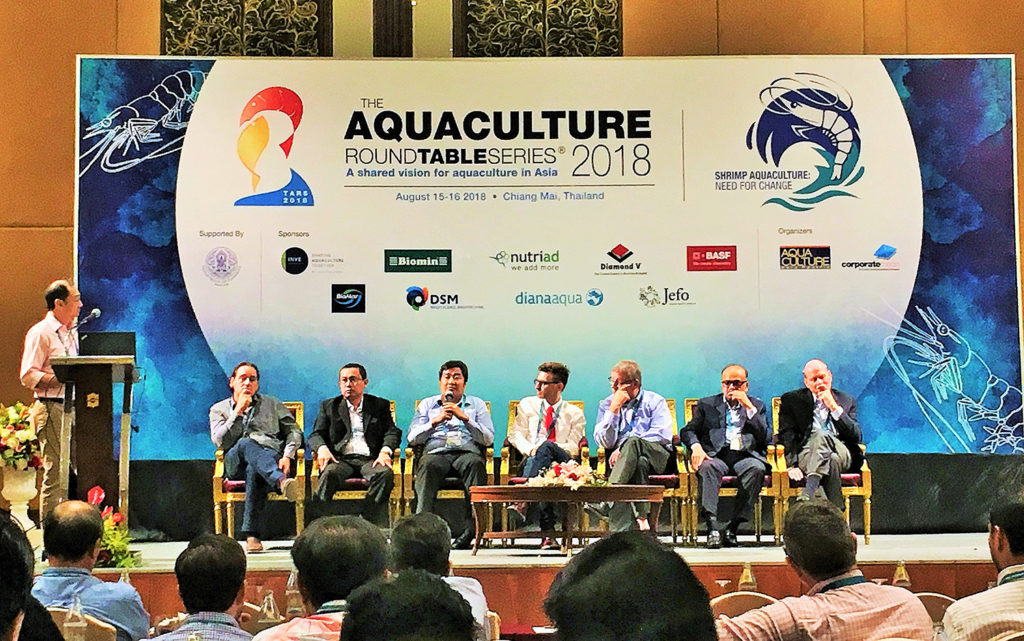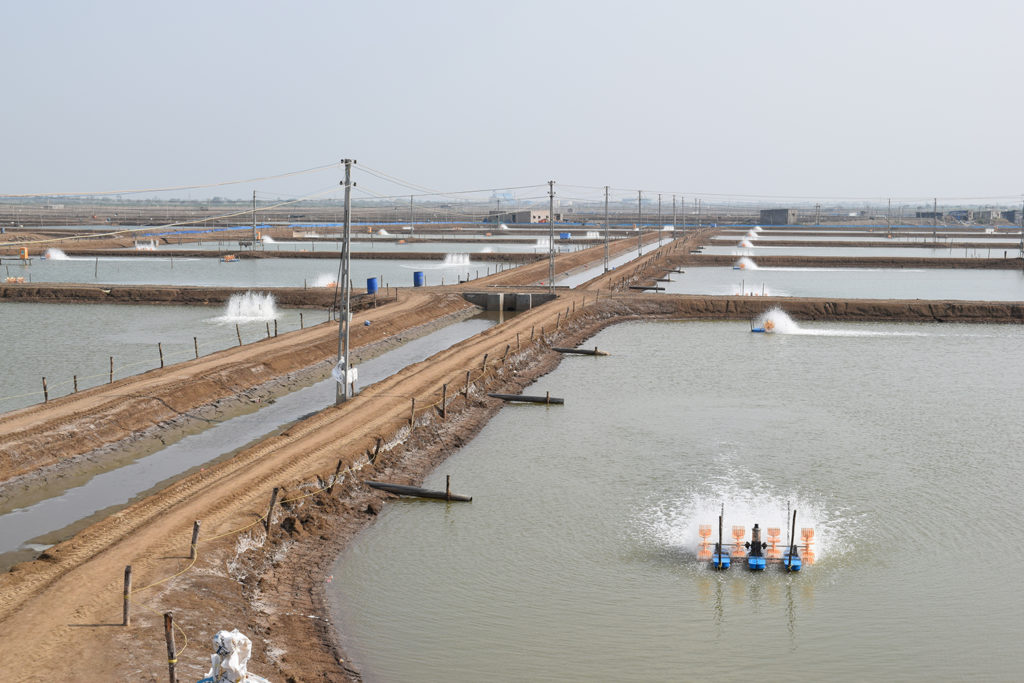‘Modelling for Sustainability’ event examines sector’s cross-cutting challenges

Environmental degradation, climate change and the proliferation of pathogens are all challenging the global farmed shrimp sector as it seeks to grow and improve its sustainability credentials, according to one of the world’s leading shrimp producers based in Thailand.
Robins McIntosh, executive VP at Pokphand Foods Public Company, discussed the shrimp industry’s past and potential future at the 2019 INFOFISH World Shrimp Conference and Exposition in Bangkok earlier this month during his keynote address. McIntosh’s remarks reflected the event’s overall theme – “Modelling for Sustainability” – as he highlighted the different models that shrimp farmers have employed during the industry’s evolution over four-plus decades.
Shrimp farming has changed dramatically over this span of time, mostly due to necessity, McIntosh explained. It transformed from what he called its original “Generation 1” model (comprised of large, 5- to 30-hectare ponds with no aeration, producing 500 kg to 3 metric tons per hectare), to what he dubbed a “Generation 5” model (small, 0.2 to 0.5-ha ponds, total recirculation of water and waste capture, with more environmental controls to produce 30 to 60 MT per ha).
“Shrimp broodstock raceways demonstrate the possibilities of controlled systems, with Generation 5 systems currently being developed in Vietnam, China and Thailand, with smaller ponds and tanks, shaded and covered to reduce environmental fluctuations, better aeration to provide optimum oxygen levels at the bottom, and designed for efficient waste removal from the bottom.”
Mcintosh said the Generation 5 model requires “healthy, disease-free postlarvae from modern hatcheries with sanitation, quality control, automation, recycling, no ablation, a reduction in the use of fresh feeds and no antibiotics use for ‘pseudo health’ control.”
Despite this multi-step maturation over more than three decades, the industry’s potential still has not been met, he added.
“We as an industry have never reached sustainability,” said McIntosh, with disease management always the primary challenge.
But with each challenge there have been positive change. McIntosh noted that the industry’s advancements in biosecurity were achieved largely as the result of challenging disease outbreaks like early mortality syndrome (EMS), which cut global shrimp production by roughly one-third earlier this decade.
McIntosh also pointed out that disease-causing pathogens like Vibrio spp. are now proliferate in warmer waters, but the greater threat has been self-inflicted. The development of large areas of intense monoculture of shrimp, particularly in Asia, with many farms stocking their ponds at a high density, means that aquaculture has made itself susceptible to the same laws of nature as experienced by terrestrial agriculture.
“Environmental carrying capacity and intensification and monoculture brings [disease] epidemics,” he said. “In the post-EMS area, we must recognize that we have some fundamental issues with aquatic health today, and we must solve the continued, chronic ‘no name’ losses in our current production systems today. Survival never recovered to pre-EMS levels, and we have higher variances now with lower levels of predictability.”
“The trend for lesser international cooperation must be reversed. The increased movement of livestock, both intentional and unintentional, increases the likelihood of emergent pathogens. A sustainable model for shrimp aquaculture must consider all the stakeholders.”
He closed his remarks by calling for greater international cooperation to beef up biosecurity protocols in a concerted effort to limit the transmission of costly disease-causing pathogens.
“The greatest challenge for the farmer and the shrimp industry of today is the establishment of sustainable practices that reduce the inherent costs while enhancing the reliability of farmed shrimp production,” he said. “The industry, therefore, needs to examine itself and its approaches working towards establishing a sector with more consistent production and employing better practices – including regulations – that would ensure a better future than we could have expected, given our past history.”

The Thai experience
Dr. Somsak Paneetatyasai, president of the Thai Shrimp Association, talked about the development of modern shrimp culture in Thailand starting in the mid-1990s, in his presentation “Shrimp Aquaculture Challenges and Issue: The Thai Experience.”
In the 35 years since then, the country has faced many disease challenges that have caused production setbacks, great losses to farmers and hindered the growth of the entire shrimp industry.
Support from the Thai Department of Fisheries, academic institutes, research institutes, and the private sector has helped to find solutions to minimize the impact on the industry without the indiscriminate use of antibiotics, he said.
“Through these efforts, Thailand has become one of the pioneer countries in promoting bio-secure and probiotic shrimp farming,” said Paneetatyasai. “Since early 2000, the Thai shrimp industry foresaw the need to reduce its dependence on wild broodstock and improve the growth performance of shrimp. This led to the private sector investing in domestication of genetically improved broodstock, devoting a great deal of time, energy, and capital to provide the best post larvae for farmers. Thai shrimp broodstock is highly sought after among the major shrimp culture countries, especially the broodstock produced by Charoen Pokphand Foods.”
Dr. Olivier Decamp, product manager at Inve Asia Services Ltd. in Thailand, reviewed protocols combining nutrition, health and environment management, with attention paid to their contribution to sustainable production. In in his talk “Nutrition and Beyond: Challenges Faced by Global Shrimp Industry,”, he stated: “Shrimp aquaculture is facing a range of challenges and issues. Some of these, such as diseases and low farm-gate prices, have led many farmers to reduce their costs, thus having implications on biosecurity, environment management and the nutritional quality of feed.”
Decamp then mentioned that the lower investments throughout the rearing cycle at hatchery, nursery and farm level have consequences on the performance of animals and on the productivity; that feed with the correct physical and nutritional properties give a clear advantage in the hatchery and nursery phases; and these benefits will be borne out in the later stages.
“The price pressure on feed manufacturers is preventing many of them from incorporating ingredients that would support farmers, which has led to the development of protocols combining bulk feed with health boosters or specialty feeds,” said Decamp.
The modernizing Middle East
Haydar H Al Sahtout (adviser, Saudi Aquaculture Society, Saudi Arabia), in his talk “Middle East Shrimp Industry: Current Trends and Expansion Plans,” reported that the increasing global demand for shrimp is “satisfied by modern aquaculture techniques and improved processing and logistics methods. Shrimp culture is spread all around the subtropical and tropical regions of the world, with non-traditional aquaculture countries emerging rapidly on the global scene.”
Al Sahtout then discussed the development of shrimp farming in the Middle East region, which started in the early 1990s and primarily along the coast of the Red Sea, initially focusing mainly on the culture of black tiger shrimp (Penaeus monodon).
However, because of the species’ high susceptibility to disease, farmers switched to P. indicus in the early 2000s. However, an epidemic of white spot disease in the early 2010s forced the regional industry to restructure again, and SPF P. vannamei stocks were introduced and strict biosecurity measures implemented, mainly by the government of Saudi Arabia.
In 2018, Saudi Arabia was the largest producer in the region, with production reaching over 65,000 MT, of which the bulk is exported to more than 30 countries worldwide.
In the Middle East region, Iran ranks second with an estimated production of around 46,000 MT, produced mainly in the country’s southern provinces; Egypt is third with an estimated production of 7,000 MT. The production of the other countries in the Middle East is marginal.
“Prospects for further growth are high, especially along the coast of the Red Sea, as shown by the increasing interest by international investors over the past few years,” Al Sahtout concluded. “The accumulated know-how, coupled by favorable conditions, strict biosecure policies, as well as government support, guarantee the further development of the shrimp industries in the region.”
More monodon versus vannamei
Dr. Manoj M Sharma, director of Mayank Aquaculture in India, contrasted the two main species of farmed shrimp – black tigers (Penaeus monodon) and Pacific whites (Litopenaeus vannamei) and their production characteristics in India.
“The commercial shrimp aquaculture sector was once synonymous with P. monodon, with Indian black tigers being the primary export shrimp species for some 25 years. However, due to repeated disease problems, farmers switched to the American white leg shrimp, P. vannamei in 2009,” he said.
Today, India is the No. 1 producer and exporter of shrimp, the bulk of it P. vannamei due to its high production capacity and availability of healthy (specific pathogen free, specific pathogen resistant and high-health) seedstock.
In his concluding remarks he said producers are seeking to return to P. monodon production, or “do vannamei the tiger way.”
The importance of biosecurity
Shrimp farming plays an important role in poverty alleviation, improving food security and human nutrition, rural employment and foreign income generation, said Dr. Eduardo Leano, coordinator of the Aquatic Animal Health Programme, Network of Aquaculture Centres in Asia-Pacific (NACA), Thailand.
Dr. Leano presented on “Biosecurity in Shrimp Aquaculture” and noted that over the past 30 years the sector has experienced boom-and-bust cycles due to outbreaks of several transboundary diseases. He estimated that approximately 60 percent of the disease losses in shrimp aquaculture are caused by viral pathogens and 20 percent by bacterial pathogens, while losses due to fungi and parasites are relatively small.
Dr. Leano identified the top emerging threats in the shrimp culture industry as the protozoan disease hepatopancreatic microsporidiosis, caused by Enterocytozoon hepatopenaei (HPM-EHP); and the viral diseases viral covert mortality disease (VCMD) and shrimp haematocyte iridescent virus (SHIV).
“Efficient biosecurity is considered to be the most effective measure in preventing the entry of pathogenic microorganisms into the shrimp culture system,” he said. “However, this is easier said than done, as most shrimp culture operations in the region have limited capacity to implement biosecurity measures, especially at the farm level. The message is that despite these devastating shrimp disease threats, continuous increases in production are possible when culture operations are efficiently managed through the implementation of improved biosecurity measures.”
Confusing acronyms
Domestication and genetic improvement programs are moving the industry forward, said McIntosh of CP Foods in his discussion “Fact, Truths and Myths about SPF, SPR and SPT Shrimp in Aquaculture.”
He specifically addressed several new terminologies and products, such as specific pathogen resistant (SPR) shrimp, specific pathogen tolerant (SPT) shrimp and even “all pathogen exposed” (APE) shrimp, which were adopted by the shrimp industry vocabulary and became commercial.
This led to confusion in the shrimp industry about the meaning, relationship and significance of these new terms with respect to specific pathogen free (SPF) shrimp stocks. In his talk, Mcintosh clarified these concepts and provided science-based definitions, reconfirming the importance of developing, maintaining and using domesticated, SPF shrimp (which may also achieve SPR and/or SPT status) to reduce the risk of disease outbreaks and increase production and profit.
“Each of this type of products have specific sanitary and genetic characteristics which makes them more or less suitable to the different culture systems.”
Assessing risk and market requirements
Evelyne Nusalim, executive director of the Indonesia Food Safety Institute, presented the talk “Achieving sustainability in food safety: An ethical code as corporate social responsibility?” and addressed fraudulent practices industry and how shareholders can limit their exposure to risk.
“The European Union’s (EU) trade flows for fisheries and aquaculture products are the highest in the world, with 70 percent of it imported,” she noted. However, fraudulent practices concerning imported seafood products in the EU market are among the highest as well, including unapproved treatment and/or processing (30 percent), the replacement, dilution and removal of products (30 percent) and mislabeling (33 percent) and others (7 percent).
One of the primary reasons for failure to comply with the EU regulations is the lack of technical skills regarding the correct treatment and processing of the products as well as knowledge on the legal requirements, she said. Stringent controls and temporary bans on imports have been carried out to discourage non-compliance.
“Should seafood producers wait for ‘punishment’ by other countries or should they take the initiative to prevent fraud? Honor, honesty and a sense of order should be the pillars of an ethical code for food, based on the integrity of seafood business operators,” she said. “This code should be part of the corporate social responsibility policy of every business operator, for the sake of consumer protection.”
Roy D. Palmer, executive director of the Association of International Seafood Professionals in Australia, explored whether certification or adoption on traceability technology like blockchain could move the industry forward in his event-ending discussion, “Overview on Shrimp Industry Risk Assessment.”
“We have reviewed most aspects of the industry at this event but what have we missed and how can we improve as we move forward?” he asked.
“How are we connecting to global consumers and communicating the benefits of shrimp? When shrimp is properly handled and cooked, the risks are minimal and as an industry it is important that we all share in improving our position as once any issue involving seafood safety hits the headlines then everyone suffers – what is your role in this? How can we individually and collectively change this thinking and get the industry on the front foot?”
Editor’s note: The 2019 INFOFISH World Shrimp Conference and Exposition brought together more than 250 attendants and a program with 32 speakers from around the world, representing all segments of the shrimp farming industry.
Follow the Advocate on Twitter @GAA_Advocate
Now that you've reached the end of the article ...
… please consider supporting GSA’s mission to advance responsible seafood practices through education, advocacy and third-party assurances. The Advocate aims to document the evolution of responsible seafood practices and share the expansive knowledge of our vast network of contributors.
By becoming a Global Seafood Alliance member, you’re ensuring that all of the pre-competitive work we do through member benefits, resources and events can continue. Individual membership costs just $50 a year.
Not a GSA member? Join us.
Author
-

Darryl E. Jory, Ph.D.
Editor Emeritus
Global Aquaculture Alliance[103,114,111,46,101,99,110,97,105,108,108,97,97,103,64,121,114,111,106,46,108,121,114,114,97,100]
Tagged With
Related Posts

Intelligence
10 takeaways from GOAL 2019 in Chennai, India
The Global Aquaculture Alliance held its GOAL conference in Chennai, India, and recruited a host of experts in various fields to share their expertise.

Intelligence
Aquaculture 2019: Triennial meeting examines global industry status
The triennial Aquaculture 2019 meeting – which also celebrated the 50thanniversary of the World Aquaculture Society – featured all segments of the aquaculture value chain during 104 technical sessions.

Intelligence
At Aquaculture Roundtable Series, talk of change for Thai shrimp
The theme of the Aquaculture Roundtable Series in Chiang Mai was “Need For Change.” That means innovations in all production phases of Thai shrimp.

Intelligence
Can India sustain its farmed shrimp boom?
Long a global leader in farmed fish production, India has transitioned into an aquaculture powerhouse. Can its expanding shrimp sector keep the rapid pace?

